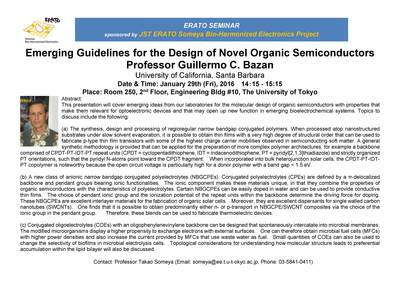TOPICS
- 2016
January 29th (Fri), Seminar Announcement: Prof. Guillermo C. Bazan "Emerging Guidelines for the Design of Novel Organic Semiconductors"

Speaker: Prof. Guillermo C. Bazan
Center for Polymers and Organic Solids
Department of Chemistry & Biochemistry
University of California, Santa Barbara
University of California, Santa Barbara
Title: Emerging Guidelines for the Design of Novel Organic Semiconductors
Date: January 29th (Fri), 2016
Time:14:00-15:00
Place: Room 250, 2nd Floor, Engineering Bldg #10, The University of Tokyo
Abstract:
Sponsor: JST ERATO
Contact: Professor Takao Someya
Date: January 29th (Fri), 2016
Time:14:00-15:00
Place: Room 250, 2nd Floor, Engineering Bldg #10, The University of Tokyo
Abstract:
This presentation will cover emerging ideas from our laboratories for the molecular design of organic semiconductors with properties that make them relevant for optoelectronic devices and that may open up new function in emerging bioelectrochemical systems. Topics to discuss include the following:
(a) The synthesis, design and processing of regioregular narrow bandgap conjugated polymers. When processed atop nanostructured substrates under slow solvent evaporation, it is possible to obtain thin films with a very high degree of structural order that can be used to fabricate p-type thin film transistors with some of the highest charge carrier mobilities observed in semiconducting soft matter. A general synthetic methodology is provided that can be applied for the preparation of more complex polymer architectures, for example a backbone comprised of CPDT-PT-IDT-PT repeat units (CPDT = cyclopentadithiophene, IDT = indacenodithiophene, PT = pyridyl[2,1,3]thiadiazole) and strictly organized
PT orientations, such that the pyridyl N-atoms point toward the CPDT fragment. When incorporated into bulk heterojunction solar cells, the CPDT-PT-IDTPT
copolymer is noteworthy because the open circuit voltage is particularly high for a donor polymer with a band gap < 1.5 eV.
(b) A new class of anionic narrow bandgap conjugated polyelectrolytes (NBGCPEs). Conjugated polyelectrolytes (CPEs) are defined by a π-delocalized
backbone and pendant groups bearing ionic functionalities. The ionic component makes these materials unique, in that they combine the properties of organic semiconductors with the characteristics of polyelectrolytes. Certain NBGCPEs can be easily doped in water and can be used to provide conductive thin films. The choice of pendant ionic group and the ionization potential of the repeat units within the backbone determine the driving force for doping. These NBGCPEs are excellent interlayer materials for the fabrication of organic solar cells. Moreover, they are excellent dispersants for single walled carbon nanotubes (SWCNTs). One finds that it is possible to obtain predominantly either n- or p-transport in NBGCPE/SWCNT composites via the choice of the ionic group in the pendant group. Therefore, these blends can be used to fabricate thermoelectric devices.
(c) Conjugated oligoelectrolytes (COEs) with an oligophenylenevinylene backbone can be designed that spontaneously intercalate into microbial membranes.
The modified microorganisms display a higher propensity to exchange electrons with external surfaces. One can therefore obtain microbial fuel cells (MFCs)
with higher power densities and also increase the current provided by MFCs that use waste water as fuel. Small quantities of COEs can also be used to change the selectivity of biofilms in microbial electrolysis cells. Topological considerations for understanding how molecular structure leads to preferential accumulation within the lipid bilayer will also be discussed.
Sponsor: JST ERATO
Contact: Professor Takao Someya

